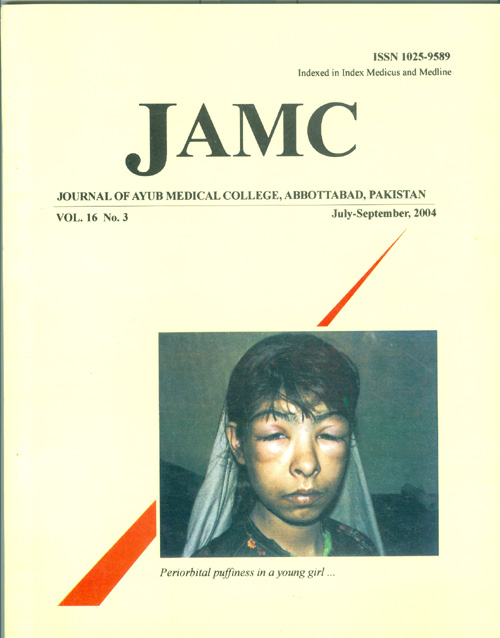A REVIEW OF SEPTIC INDUCED ABORTION CASES IN ONE YEAR AT KHYBER TEACHING HOSPITAL,PESHAWAR
Abstract
Background: Working in a tertiary level hospital we get complicated cases as a result of termination or attempts at termination of unwanted pregnancies. Most of the patients that we get are complicated and need expensive treatments including surgery. This study was conducted to assess the out come of septic induced abortion cases in a year. Methods: It was conducted at the Department of Obstetrics and Gynaecology, unit B, Khyber Teaching Hospital, Peshawar, from 1.7.01 to 30.6.02. The data of a total of 28 patients admitted as emergency cases with septic induced abortion in above period were collected. History, management given, post operative care, complications and associated morbidity and mortality were taken into account and result compiled. Results: 78.5% patients with unsafe abortions were multi gravida. Termination was attempted at home or other small centers. 57% had history of surgical interference, 28.5% had used a mechanical device. 78.5% patients needed evacuation and curettage, 42% had laparotomy for visceral injuries. 15% patients had a subtotal hysterectomy. 57% patients had associated complications. 7.5% patients who came with septicemic shock died. Conclusion: Septic induced abortion is an important contributor to maternal morbidity and mortality, increasing the burden on not only the patients but health workers and their resources. However, it is preventable, and we suggest commitment to health education, family planning promotion and bringing down the rates of unsafe abortions as solutions to the problems.
Key words: Septic induced abortion, Methods of termination, Complications, Outcome.
References
Abou Zahr C, Royston E. Maternal Mortality. A global fact book. Geneva: World Health Organization.1991
Ashworth F Septic abortion. In: Stabile I, Grudzinskas JG, Chard T, editors. Spontaneous abortion, diagnosis and treatment. London:Springer Verlag.1992:119-32.
Jewett JF. Septic induced abortion. N Engl J Med 1973;289(14):748-9.
Lynn WA, Cohen J.Management of septic shock. J Infect Dis 1982;145:1-3.
Parker MM, Pariko JE. Septic shock, hemodynamics and pathogenesis. JAMA 1983;250:332-4.
Back RA, Bone RC. The septic syndrome, Definition and clinical implications. J Crit Care Clin1989;5:1-2.
Bryan CS, Reynold SKL, Moore EE. Bacteriemia in obstetrics and gynecology. Obstetric Gynecol 1984;64:155-6.
WHO- The prevention and management of unsafe abortions Geneva. WHO/msm/1992;5.
Clinical management of abortion complications: A practical guide. Geneva. WHO/ FHE / MSM / 1994;1.
Tayyab S, Samad N. Illegally induced abortions. A Study of 37 cases J Coll Physicians Surg Pakistan 1996;6:104-6.
Zaidi S, Mastoor S, Jaffery H. Fetal deaths in induced abortions. J Coll Physians Surg Pakistan 1993;3:20-3.
Ladipo OA. Preventing and managing complications of induced abortions in third world countries. Int J Gynecol Obstet 1989;30:21-8.
Bashir A. Maternal mortality in Faisalabad city. A longitudinal study. Gynecologist 1993;3:14-20.
A tabulation of available data on the frequency and mortality of unsafe abortions Geneva, WHO/MCH/ 90-4, 1990
Cavanagh D, Knuppel RA, Shepherd JH. Septic shock and the obstetrician /gynecologist. South Med J 1982;75: 809-10.
Sharma JB, Umanaktala, Kumar A, Malhotra M. Complications and management of septic abortion, a five year study. J Obstet Gyn (Indian issue) 2001;6:166-9.
Stevenson MM, Rad cliffe KW. Presenting pelvic infection after abortion. International journal of STD and AIDS 1995;6:305-12.
Downloads
How to Cite
Issue
Section
License
Journal of Ayub Medical College, Abbottabad is an OPEN ACCESS JOURNAL which means that all content is FREELY available without charge to all users whether registered with the journal or not. The work published by J Ayub Med Coll Abbottabad is licensed and distributed under the creative commons License CC BY ND Attribution-NoDerivs. Material printed in this journal is OPEN to access, and are FREE for use in academic and research work with proper citation. J Ayub Med Coll Abbottabad accepts only original material for publication with the understanding that except for abstracts, no part of the data has been published or will be submitted for publication elsewhere before appearing in J Ayub Med Coll Abbottabad. The Editorial Board of J Ayub Med Coll Abbottabad makes every effort to ensure the accuracy and authenticity of material printed in J Ayub Med Coll Abbottabad. However, conclusions and statements expressed are views of the authors and do not reflect the opinion/policy of J Ayub Med Coll Abbottabad or the Editorial Board.
USERS are allowed to read, download, copy, distribute, print, search, or link to the full texts of the articles, or use them for any other lawful purpose, without asking prior permission from the publisher or the author. This is in accordance with the BOAI definition of open access.
AUTHORS retain the rights of free downloading/unlimited e-print of full text and sharing/disseminating the article without any restriction, by any means including twitter, scholarly collaboration networks such as ResearchGate, Academia.eu, and social media sites such as Twitter, LinkedIn, Google Scholar and any other professional or academic networking site.










